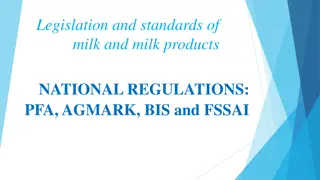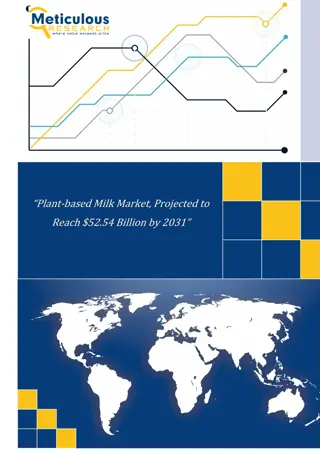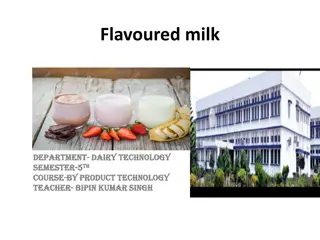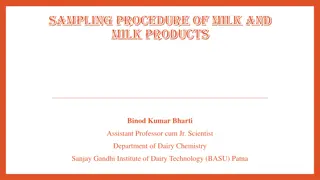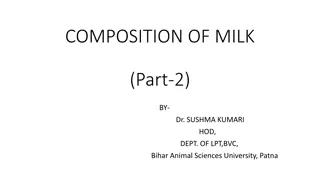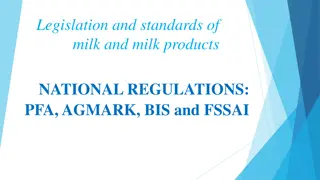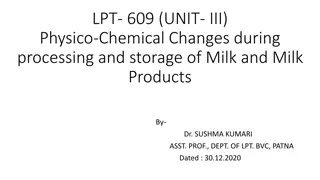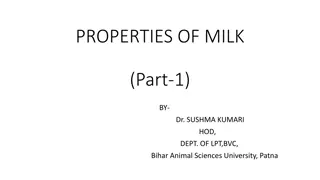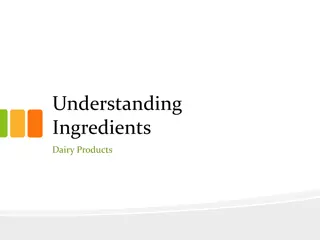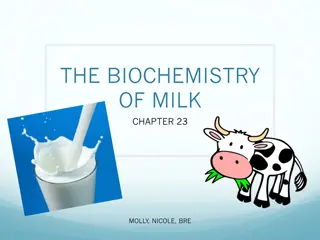Overview of Market Milk: Types, Standards, and Microbiological Quality
Market milk encompasses various types such as standardized, full cream, and skimmed milk, each with specific standards and microbiological requirements. Factors affecting microbiological quality include raw milk quality and processing steps. Understanding these aspects is crucial for maintaining the safety and quality of market milk products.
Download Presentation

Please find below an Image/Link to download the presentation.
The content on the website is provided AS IS for your information and personal use only. It may not be sold, licensed, or shared on other websites without obtaining consent from the author. Download presentation by click this link. If you encounter any issues during the download, it is possible that the publisher has removed the file from their server.
E N D
Presentation Transcript
TYPE And standard OF MARKET MILK Dr Sanjeev Kumar Dairy Technology
INTRODUCTION Market milk refers to fluid milk that is sold for direct consumption and consumed on the farm and that used for the manufacture of dairy products. The market milk industry in India was started in 1950-51 with the establishment of Central Dairy of Aarey Milk Colony. thus excludes milk
Types and standards of market milk Class of milk Designation Locality Minimum Percent Mixed Milk Raw, pasteurized, boiled, flavour and sterilized All India 4.5 8.5 Standardized Milk Pasteurized, flavoured and sterilized All India 4.5 8.5 Recombined Milk Pasteurized, flavoured and sterilized All India 3.0 8.5 Full Cream Milk Pasteurized, and sterilized All India 6.0 9.0 Tonned Milk Pasteurized, flavoured and sterilized All India 3.0 8.5 Double Tonned Milk Pasteurized, flavoured and sterilized All India 1.5 9.0 Skimmed Milk Raw, pasteurized, boiled, flavour and sterilized All India NMT 0.5 8.7 FSSAI, 2006
Types and standards of market milk Note: (i) When milk is offered for sale without indication of the class, the standards prescribed for buffalo milk shall apply. (ii) The heat treatment for the various designated milk shall be as follows: Designation Heat Treatment Raw Nil Pasteurized Pasteurization Boiled Boiling Flavoured Pasteurization or sterilization Sterilized Sterilization
Microbiological Standards of Market Milk Requirements Sampling Plan Pasteurized Milk Total Plate Count m 30,000/g M 50,000/g Coliform Count m - M Less than 10/g E. Coli M Absent/g Salmonella M Absent/25g Staph. aureus (coagulase positive) m - M Less than 10/g Listeria monocytogenes M Absent/g Where, m = represents an acceptable level and values above it are marginally acceptable in terms of the sampling plan. M = separates marginally acceptable quality from unsatisfactory/potentially hazardous quality. Values above M are unacceptable in terms of sampling plan.
Factors affecting Microbiological quality of Market milk 1. Raw milk quality Depends on number & types of microorganisms in raw milk. Inferior quality leads to inferior product and vice versa. Psychrotrophs (including heat stable lipases and proteases) Thermodurics & thermophilic Coliforms Toxigenic microflora So before proceeding, assess quality of raw milk by various platform and microbiological tests. Subsequent spoilage and public health problems in market milk
2. Processing Steps Miscellaneous operations before and during processing significantly affects microbiological quality of product. Steps before processing Pumping Increases bacterial count without increasing the actual number of bacteria due to mechanical breakage of bacterial clumps Improper cleaning and sanitization of pump adds to microflora. Filteration Microorganisms adhered to dirt particles on filter carried over to milk . Type of microflora depends on nature of particulate material. a) o o b) o o
Centrifugal separation Sludge material contains high amount of bacterial cells, somatic cells and coagulated proteins. Bacterial count is not reduced due to simultaneously breaking up of bacterial clumps. Increased removal of bacteria achieved by Slow milk flow Prior homogenization of milk( no sweeping effect) c) o o o d) Standardization In line standardization- uses centrifugal force Offline standarization- by addition of skim milk, cream etc. Quality depends on quality of added products. Homogenization Break down of bacterial clumps Improperly cleaned & sanitized o o o e) Increases microbial load
Steps after processing a) Pasteurization of milk Selection of time-temp. combination on basis of Destructiion of heat resistant pathogen Phosphatase test should be negative Cream line should be minimally reduced Different pasteurization process: LTLT process- 63 C/30 min HTST process- 72 C/15 sec Flash process- 75-80 C/ few sec In- bottle pasteurization o o Pros of pasteurization Destruction of pathogens and spoilage causing bacteria Increases keeping quality Inactivation of phosphatase and lipase Masking off-flavours Cons of pasteurization Unable to inactivate heat stable enzymes and Staphycoccal toxins Reduction of cream line Destruction of some vitamins and antimicrobial substances Rennet coagulation time increases
b) Sterilization of milk Complete in-bottle system: Heated in bottle at 110 -120 C for few minutes. Slow heat penetration --> growth of thermophiles, off- flavour and browning effect A two-stage process: 1st stage --> sterilization at 130 -150 C/1-20 sec followed by bottling. 2nd stage --> in-bottle treatment( 100 -110 C/10-15 min) Ultra high temperature(UHT) processing Rapidly heating milk to 130 -150 C for few seconds followed by aseptic packaging. Mode of heating may be direct or indirect. UHT treated milk must be kept without deterioration, free from microbes and toxins and microorganisms do not proliferate during storage. o o o
o Effects of UHT sterilization: Destruction of microorganisms/spores - Sterilizing efficiency of a UHT process is determined by Sterilizing Effect 1. Survival of microbial enzymes particularly heat stable lipases and proteases. Increases Keeping quality Influence on colour, taste and nutritive value of milk 3. Post-Heating Operations Cooling Rapidly cooled to below 10 C (preferably to 4-5 C) after pasteurization. Part of cooling is done by regenerative principle and part by using refrigerant non-milk coolant. 2. 3. 4. a) o o
b) Packaging o Equipment for packaging Thoroughly cleaned and sanitized Condensate contamination can be prevented using drip deflectors o Packaging materials Single service type paper or plastic containers are gaining popularity Should be non-toxic and microbiologically safe Glass container should contribute < 1 microorganism/ml & no coliform o Closure equipment, materials and procedure Closure properly designed and handled Overfilling should be avoided o Handling o Properly handled to prevent small breaks in sterilized products o Aseptic packaging of sterilized milk like UHT is of utmost importance Distribution/marketing o In tropical countries like India, product should be kept under refrigeration temperature(7.2 C or below) to prevent multiplication transporting market milk to retails shops and finally to consumers. c) of spoilage microorganisms while
Microfloraof Market Milk Microflora of Pasteurized milk Those surviving pasteurization temperature Those entering as post-pasteurization contaminants Thermoduric Microflora:- I. A. M. luteus, M. candidus, M. caseolyticus Associated with insanitation of equipments Micrococci M. lacticum, M liquifaciens Former one is most heat resistant non-sporeformer Microbacterium B. subtilis, B. cereus, B. circulans, B. polymyxa etc. These are aerobic sporeformers invariably present in past. Milk. S. thermophilus, S. faecalis, S .faecium Increasing pH and substituting peptone for tryptone increses recovery of these bacteria Bacillus Streptococcus Lb. bulgaricus, Lb. lactis Fastidious, not encountered frequently in past. milk Lactobacillus Others Arthrobacter spp., Clostridium spp.,Streptomyces spp.
Sources of thermoduric organisms: o Insanitary conditions of milking equipment o Insanitary conditions of pasteurization plant( milk stone formation and improper cleaning of rubber parts) o Repasteurization of returned pasteurized milk. Thermodurics start multiplying at warm stages during second pasteurization Significance: o Due to temperature fluctuations, these organisms produce defects such as sweet curdling, gassiness, proteolysis, bitterness etc. o Under refrigerated storage ,psychrotropic thermodurics like Bacillus and Clostridium spp.
B. Thermophilic microflora They grow pasteurization. Their upper limit for growth is 70 C. Types:- aerobic or facultative anaerobic sporeforming rods constitute majority of thermophilic microflora o Lactobacillusthermophilus o Bacillus spp. like B. stearothermophilus B. thermoacidurans B. calidolactis B. coagulans well during holder method of Sources: o Their count is less in raw milk which significantly increases during holding at high temperature This group represents dairy plant rather than farm contamination Repeated use of improperly cleaned hodling vats Residual milk foam and warm milk in dead ends/vats Repasteurization of returned milk o Increases thermophilic count
Significance: o Under ambient condtions, sporeforming bacilli cause spoilage problems like sweet curdling or bitty cream defects in pasteurized milk. C. Psychrotrophic microflora: Grow at refrigerated temperature(2 -7 C) irrespective of their optimum growth temperature. Most of them are mesophiles, some are psychrophilic Types: divided into two categories Psychrotrophic thermoduric bacteria Gram-positive rods and cocci e.g. Bacillus, Clostridium and Streptococcus. Psychrotrophic bacteria Gram-negative rods e.g. Pseudomonas, Flavobacterium, Alkaligenes, Achromobacter, Acinetobacter
Sources: o first category --> survival during pasteurization o Second category --> post pasteurization contamination o Water supplies may serve as a possible source. Significance: o At referigerated storage(7.2 C or lower) --> gram-negative psychrotrophs outgrow o At 10 C or above --> thermoduric psychrotrophs tend to outgrow o Importance of gram-negative psychrotrophs --> cause number of defects like fruity, rancid, bitter , putrid, roppiness and discoloration etc. o Minimum population required to produce defects are 107/ml
Coliform bacteria This group of organisms refer to aerobic and facultatively anaerobic, sporeforming rods which ferment lactose into acid and gas at32 C within 48hrs in presence of bile salts and dye. Types: Escherichia, Enterobacter, Citrobacter Source: Destroyed during pasteurization. Post-pasteurization contamination. Improper cleaning/sanitization Unhygienic handling practises Water supplies D. Gram-negative, non- Klebsiella and o o Major sources of contamination o o o
Significance: o Unlike water supplies, where their detection is taken as index of faecal contamination, coliform detection in pasterurized milk is taken as index of post-pasteurizartion contamination. o This group is usually traced to dairy plant. o Above 7.2 C, they cause defects like roppiness, gassiness, unclean and medicinal off-flavours and bitterness. E. Pathogenic microorganisms That survive pasteurization --> B. cereus, Cl. Perfringens, haemolytic streptococci and some viruses Through post-pasteurization contamination --> dirty habits of handlers( E.coli, Salomella) or those carried by an unhealthy handler. L. monoctogenes and Y. enterocolitica can multiply even below 7.2 C but these species are heat labile. Improper storage of contamination is equally hazardous. loose milk after such
Microflora of UHT milk Ultra-high temperature is carried out at 135 - 150 C coupled with aseptic packaging. The only microflora survive UHT treatment are bacterial spore of thermophlic bacilli( B. stearothermophilus) mesophilic bacilli and clostridia. Major spoilage organisms in heat processed milk are, B. megaterium( main cause), B. firmus, B. polymyxa, B. coagulans and Clostridium spp. Microorganisms entering packaging practices are usually associated with stagnant water on dairy floors ( Pseudomonas, Coryneform, Micrococci etc). Major defects --> coagulation, bitterness and gassiness. and sometimes to through faulty
Microflora of Boiled Milk In India, milk is boiled to 100 C for brief period before consumption. Boiling kills vegetative forms of all microbes except heat stable enterotoxins esp. of Staphylococci. Post pasteurization contamination can also occur due to improperly cleaned utensils and due to improperly heated portions of milk. Major defects--> off-flavour coagulation and gassiness. Boiled milk should be utilized within 16 hrs, particularly in absence of refrigeration. (proteolytic),













